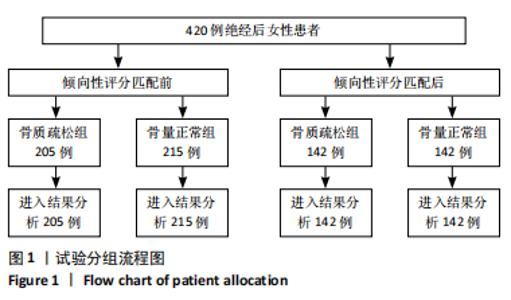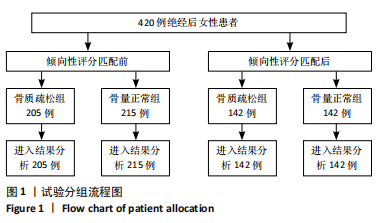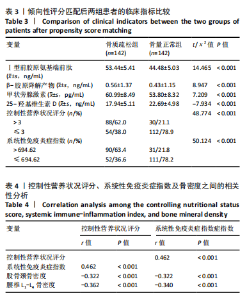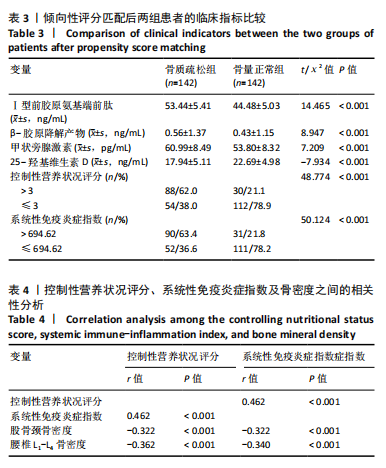Chinese Journal of Tissue Engineering Research ›› 2025, Vol. 29 ›› Issue (24): 5071-5078.doi: 10.12307/2025.743
Previous Articles Next Articles
Association of the controlling nutritional status score and systemic immune-inflammation index with postmenopausal osteoporosis
Chen Xiaoqing1, Gong Yunzhao1, 2, Chen Wei1, 2
- 1Liaoning University of Traditional Chinese Medicine, Shenyang 110847, Liaoning Province, China; 2The Second Affiliated Hospital of Liaoning University of Traditional Chinese Medicine, Shenyang 110034, Liaoning Province, China
-
Received:2024-07-27Accepted:2024-09-21Online:2025-08-28Published:2025-01-22 -
Contact:Chen Wei, MD, Chief physician, Master’s supervisor, Liaoning University of Traditional Chinese Medicine, Shenyang 110847, Liaoning Province, China; The Second Affiliated Hospital of Liaoning University of Traditional Chinese Medicine, Shenyang 110034, Liaoning Province, China -
About author:Chen Xiaoqing, Master candidate, Liaoning University of Traditional Chinese Medicine, Shenyang 110847, Liaoning Province, China Gong Yunzhao, MS, Chief physician, Liaoning University of Traditional Chinese Medicine, Shenyang 110847, Liaoning Province, China; The Second Affiliated Hospital of Liaoning University of Traditional Chinese Medicine, Shenyang 110034, Liaoning Province, China Chen Xiaoqing and Gong Yunzhao contributed equally to this work. -
Supported by:Basic Research Project for Higher Education Institutions of the Liaoning Provincial Department of Education, No. LJKMZ20221327 (to GYZ)
CLC Number:
Cite this article
Chen Xiaoqing, Gong Yunzhao, Chen Wei. Association of the controlling nutritional status score and systemic immune-inflammation index with postmenopausal osteoporosis[J]. Chinese Journal of Tissue Engineering Research, 2025, 29(24): 5071-5078.
share this article
Add to citation manager EndNote|Reference Manager|ProCite|BibTeX|RefWorks
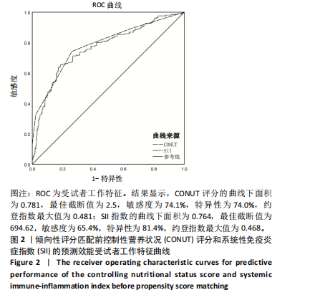
2.3 倾向性评分匹配前控制性营养状况评分和系统性免疫炎症指数预测效能的受试者工作特征曲线 利用患者的控制性营养状况评分和系统性免疫炎症指数绘制预测受试者工作特征曲线,见图2。结果显示,控制性营养状况评分的曲线下面积为0.781(95%CI 0.737-0.826,P < 0.001),最佳截断值为2.5,敏感度为74.1%,特异性为74.0%,约登指数最大值为0.481;系统性免疫炎症指数的曲线下面积为0.764(95%CI 0.718-0.810,P < 0.001),最佳截断值为694.62,敏感度为65.4%,特异性为81.4%,约登指数最大值为0.468。 根据最佳截断值,将控制性营养状况评分和系统性免疫炎症指数分为高低2组,营养不良组(评分> 3)有154例,营养正常组(评分≤3)有266例,高炎症水平组(指数> 694.62)有175例,低炎症水平组(指数≤694.62)有245例。"
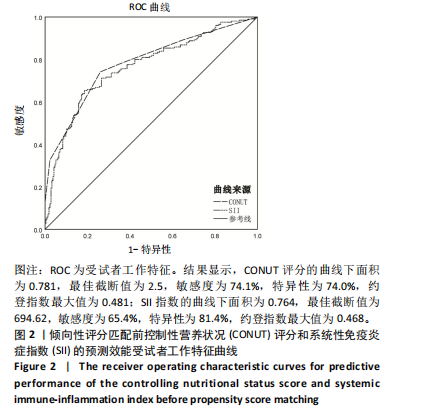

2.4 倾向性评分匹配前后两组患者基线资料比较 如表2所示,匹配前,两组患者年龄、绝经年限、体质量指数和骨折史比率比较差异有显著性意义(P < 0.05),吸烟比率和饮酒史比率比较差异均无显著性意义(P > 0.05);匹配后,共有142对患者匹配成功,两组患者各协变量(年龄、绝经年限、体质量指数、骨折史、吸烟史及饮酒史)比较差异无显著性意义(P > 0.05),并且年龄、绝经年限、体质量指数的标准化均值差异均< 0.1,表明倾向性评分匹配的应用明显减少了两组在协变量上的差异。 2.5 倾向性评分匹配后两组患者的临床指标比较 如表3所示,匹配后,骨质疏松组患者血清Ⅰ型前胶原氨基端前肽、β-胶原降解产物、甲状旁腺激素水平均高于骨量正常组(P < 0.001),25-羟基维生素D水平低于骨量正常组(P < 0.001),营养不良率和免疫炎症指数均高于骨量正常组(P < 0.001)。 2.6 控制性营养状况评分、系统性免疫炎症指数及骨密度之间相关性分析 如表4所示,控制性营养状况评分与系统性免疫炎症指数呈正相关(r=0.462,P < 0.001),即控制性营养状况评分越高,系统性免疫炎症指数可能越大。控制性营养状况评分与股骨颈骨密度(r=-0.322,P < 0.001)、腰椎L1-L4骨密度(r=-0.362,P < 0.001)呈负相关,即控制性营养状况评分越高,股骨颈和腰椎L1-L4骨密度可能越低。系统性免疫炎症指数与股骨颈骨密度(r=-0.322,P < 0.001)、腰椎L1-L4骨密度(r=-0.340,P < 0.001)呈负相关,即系统性免疫炎症指数越大,股骨颈和腰椎L1-L4骨密度可能越低。"

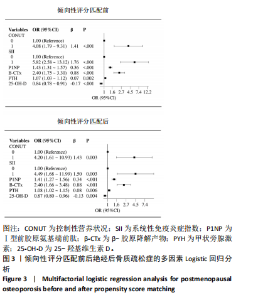
2.7 绝经后骨质疏松的多因素Logistic回归分析 多重共线性检验结果显示,控制性营养状况评分、系统性免疫炎症指数、Ⅰ型前胶原氨基端前肽、β-胶原降解产物、甲状旁腺激素和25-羟基维生素D的方差膨胀因子均< 2、容差均> 0.1,提示在这个模型中这些变量之间不存在多重共线性的风险。以绝经后是否发生骨质疏松(骨质疏松=1,骨量正常=0)为因变量,控制性营养状况评分(> 3=1,≤3=0)和系统性免疫炎症指数(> 694.62=1,≤694.62=0)作为自变量,调整Ⅰ型前胶原氨基端前肽、β-胶原降解产物、甲状旁腺激素、25-羟基维生素D变量后进行多因素Logistic回归分析,分析结果显示,匹配前后的控制性营养状况评分和系统性免疫炎症指数均为绝经后骨质疏松症的危险因素,见图3。 匹配后,与营养正常组相比,营养不良组骨质疏松症风险显著增加[OR=4.20,95%CI(1.61-10.93),P < 0.01];与低炎症水平组比较,高炎症水平组骨质疏松症风险显著增加[OR=4.49,95%CI(1.68-11.99),P < 0.01]。"
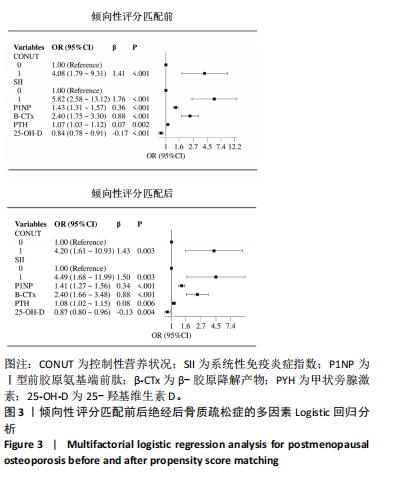
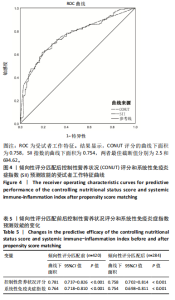
2.8 倾向性评分匹配前后控制性营养状况评分和系统性免疫炎症指数预测效能的变化 基于匹配后的患者数据,绘制受试者工作特征曲线进一步验证控制性营养状况评分和系统性免疫炎症指数的预测效能,见图4。结果显示,控制性营养状况评分的曲线下面积为0.758[95%CI(0.702-0.814),P < 0.001],系统性免疫炎症指数的曲线下面积为0.754[95%CI (0.698-0.811),P < 0.001],两者最佳截断值分别为2.5和694.62。 比较匹配前后控制性营养状况评分和系统性免疫炎症指数预测效能的变化,如表5所示。匹配后,总体样本量从420减少至284,在此过程中,控制性营养状况评分和系统性免疫炎症指数的曲线下面积也相应地从0.781和0.764下降至0.758和0.754,这种下降反映了匹配过程中对混杂因素的有效控制。尽管模型的性能有所波动,但结果提示控制性营养状况评分和系统性免疫炎症指数在绝经后骨质疏松症方面仍具有一定的预测效能。"
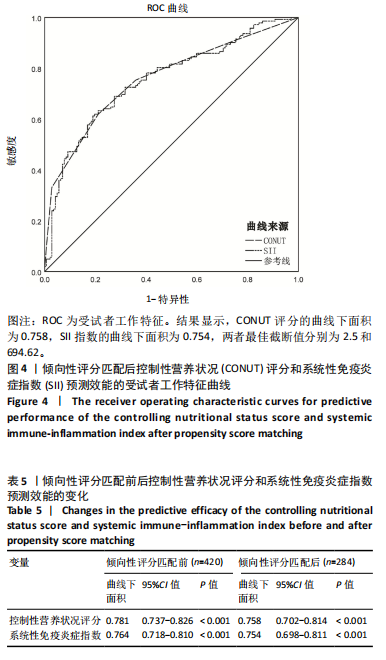
| [1] 中华医学会骨质疏松和骨矿盐疾病分会,章振林.原发性骨质疏松症诊疗指南(2022)[J].中国全科医学,2023,26(14):1671-1691. [2] ZHU Z, YU P, WU Y, et al. Sex specific global burden of osteoporosis in 204 countries and territories, from 1990 to 2030: an age-period-cohort modeling study. J Nutr Health Aging. 2023;27(9):767-774. [3] SHANGGUAN X, XIONG J, SHI S, et al. Impact of the malnutrition on mortality in patients with osteoporosis: a cohort study from NHANES 2005-2010. Front Nutr. 2022;9:868166. [4] TABATABAI LS, SELLMEYER DE. Nutritional supplements and skeletal health. Curr Osteoporos Rep. 2021;19:23-33. [5] ALABADI B, CIVERA M, MORENO-ERRASQUIN B, et al. Nutrition-Based Support for Osteoporosis in Postmenopausal Women: A Review of Recent Evidence. Int J Womens Health. 2024;16:693-705. [6] JIANG N, AN J, YANG K, et al. NLRP3 inflammasome: a new target for prevention and control of osteoporosis? Front Endocrinol (Lausanne). 2021;12:752546. [7] FISCHER V, HAFFNER-LUNTZER M. Interaction between bone and immune cells: Implications for postmenopausal osteoporosis. Semin Cell Dev Biol. 2022;123:14-21. [8] DE ULíBARRI JI, GONZÁLEZ-MADROÑO A, DE VILLAR NG, et al. CONUT: a tool for controlling nutritional status. First validation in a hospital population. Nutr Hosp. 2005;20(1):38-45. [9] 杨珍珍,赵晶,彭瑜,等.CONUT评分与急性心肌梗死患者死亡的相关性研究[J].中国循环杂志,2018,33(10):978-983. [10] 冶学燕,仝雪薇,邓朝晖,等.2型糖尿病住院患者营养状况评估及影响因素分析[J].国际检验医学杂志,2020,41(11):1310-1313. [11] 何海艳,刘右萍,张睿,等.控制营养状态评分和相关指标在骨肉瘤患者预后预测中的价值[J].肿瘤代谢与营养电子杂志,2023, 10(6):813-819. [12] 任莎莎,简文,刘自明.系统免疫炎症指数和骨骼肌质量指数与肝硬化合并肝癌患者术后预后的关系[J].现代肿瘤医学,2020, 28(10):1693-1697. [13] 彭江南,王昊晨,张亮,等.老年髋部骨折后静脉血栓栓塞症风险预测模型的构建及预测效能[J].中南大学学报(医学版),2021, 46(2):142-148. [14] 阮汉江,李新武,武鹏,等.系统免疫炎症指数在强直性脊柱炎中的预测价值研究[J].中国免疫学杂志,2022,38(4):457-461. [15] JEONG TD, LEE W, CHOI SE, et al. Relationship between Serum Total Cholesterol Level and Serum Biochemical Bone Turnover Markers in Healthy Pre-and Postmenopausal Women. Biomed Res Int. 2014; 2014(1):398397. [16] 张晓,钱志远,顾柏林,等.骨密度与血清白蛋白、钙、镁、磷及血红蛋白的相关性研究[J].中国骨质疏松杂志,2015,21(3):292-297.
[17] NAGAYAMA Y, EBINA K, TSUBOI H, et al. Low serum albumin concentration is associated with increased risk of osteoporosis in postmenopausal patients with rheumatoid arthritis. J Orthop Sci. 2022;27(6):1283-1290. |
| [1] | Li Guangzheng, Li Wei, Zhang Bochun, Ding Haoqin, Zhou Zhongqi, Li Gang, Liang Xuezhen. A prediction model for sarcopenia in postmenopausal women: information analysis based on the China Health and Retirement Longitudinal Study database [J]. Chinese Journal of Tissue Engineering Research, 2026, 30(4): 849-857. |
| [2] |
Huang Xiaobin, Ge Jirong, Li Shengqiang, Xie Lihua, Huang Jingwen, He Yanyan, Xue Lipeng.
Mechanisms of different yin nourishing and kidney tonifying methods on osteoclastysis pathway in ovariectomized rats #br#
#br#
[J]. Chinese Journal of Tissue Engineering Research, 2025, 29(6): 1214-1219.
|
| [3] | Wang Dongyang, Yang Qiaohui, Lin Xinchao. Relationship between vitamin D levels and reproductive characteristics and exercise dietary situation in postmenopausal women [J]. Chinese Journal of Tissue Engineering Research, 2025, 29(5): 1021-1025. |
| [4] | Yan Laijun, Ge Haiya, Wang Zhengming, Yang Zongrui, Niu Lifeng, Zhan Hongsheng. Mechanism by which Tongdu Huoxue Decoction inhibits macrophage inflammation to delay intervertebral disc degeneration in rats [J]. Chinese Journal of Tissue Engineering Research, 2025, 29(32): 6851-6857. |
| [5] | Du Juan, Zhang Yi, Hao Quanshui. Effects of exercise on activation of microglia and astrocytes and neuronal apoptosis in depressed rats [J]. Chinese Journal of Tissue Engineering Research, 2025, 29(29): 6243-6248. |
| [6] | Zhang Ziyu, Chen Longhao, Sheng Wei, Lyu Hanzhe, Shen Ying, Wang Binghao, Lyu Zhizhen, Lyu Lijiang. Application of artificial intelligence in the diagnosis and treatment of lumbar disc herniation: evolution towards standardization, efficiency, and precision of diagnosis and treatment methods [J]. Chinese Journal of Tissue Engineering Research, 2025, 29(29): 6269-6276. |
| [7] | Wu Yonghao, Zhu Shuaiqi, Li Yuqiao, Zhang Chenfei, Xia Weiwei, Zhu Zhenqi, Wang Kaifeng. Correction effect of local kyphosis of the spine after percutaneous kyphoplasty in super-aging patients with vertebral compression fractures [J]. Chinese Journal of Tissue Engineering Research, 2025, 29(27): 5854-5861. |
| [8] | Yang Feng, Xu Jinfan, Long Huan, Yang Fengchun, Zhang Guixin, Jiang Tao, Chen Qingzhen, Shao Min. Estrogen receptor alpha-activated adenosine monophosphate-activated protein kinase signaling pathway promotes proliferation and differentiation of osteoblasts [J]. Chinese Journal of Tissue Engineering Research, 2025, 29(24): 5061-5070. |
| [9] | Wang Runzheng, Fu Su, Dong Chao, Li Dongzhe, Wang Yongkui. Relationship between bone mineral density and lumbar disc degeneration in middle-aged and elderly men and postmenopausal women [J]. Chinese Journal of Tissue Engineering Research, 2025, 29(24): 5079-5085. |
| [10] | Qiao Zhengji, Chai Niubing, Zheng Luyao, Gao Yunna, Wang Yang. Effect of whole‑body vibration training on bone mineral density in postmenopausal women: a meta‑analysis [J]. Chinese Journal of Tissue Engineering Research, 2025, 29(24): 5195-5202. |
| [11] | Mou Limin, Li Chao, Zhang Wenhao, Shi Zhengyu, Deng Yingjie, Fang Rui. Correlation between body mass index and efficacy after medial unicompartmental knee arthroplasty in postmenopausal women [J]. Chinese Journal of Tissue Engineering Research, 2025, 29(21): 4537-4544. |
| [12] | Gao Haoran, Zhang Heling, Jia Fanglin, Guo Di, Jing Li, Shi Yaozhou, Song Hanlin, Gao Xiao, Feng Hu. Risk factors related to intradural lumbar disc herniation analyzed by propensity score matching [J]. Chinese Journal of Tissue Engineering Research, 2025, 29(15): 3199-3205. |
| [13] | Zhang Xiaoyun, Li Kunjian, Mo Jian, Chai Yuan, Huang Yourong . Current status and trends of research on animal models of postmenopausal osteoporosis: a bibliometric visualization analysis [J]. Chinese Journal of Tissue Engineering Research, 2025, 29(14): 3070-3080. |
| [14] | Li Zhipeng, Huan Dawei, Yuan Zhaofeng, Ding Kai, Qiu Yue, Xia Tianwei, Shen Jirong. Mid- and long-term state after total hip arthroplasty versus hemiarthroplasty for femoral neck fractures in the elderly: evaluation using propensity score matching method [J]. Chinese Journal of Tissue Engineering Research, 2024, 28(24): 3839-3844. |
| [15] | Wang Zhenyu, Xia Yuan, Lu Yue, Pan Xinyong, Li Yongjie. Effects of different resistance training programs on bone mineral density in postmenopausal women: a network Meta-analysis [J]. Chinese Journal of Tissue Engineering Research, 2023, 27(28): 4586-4592. |
| Viewed | ||||||
|
Full text |
|
|||||
|
Abstract |
|
|||||
